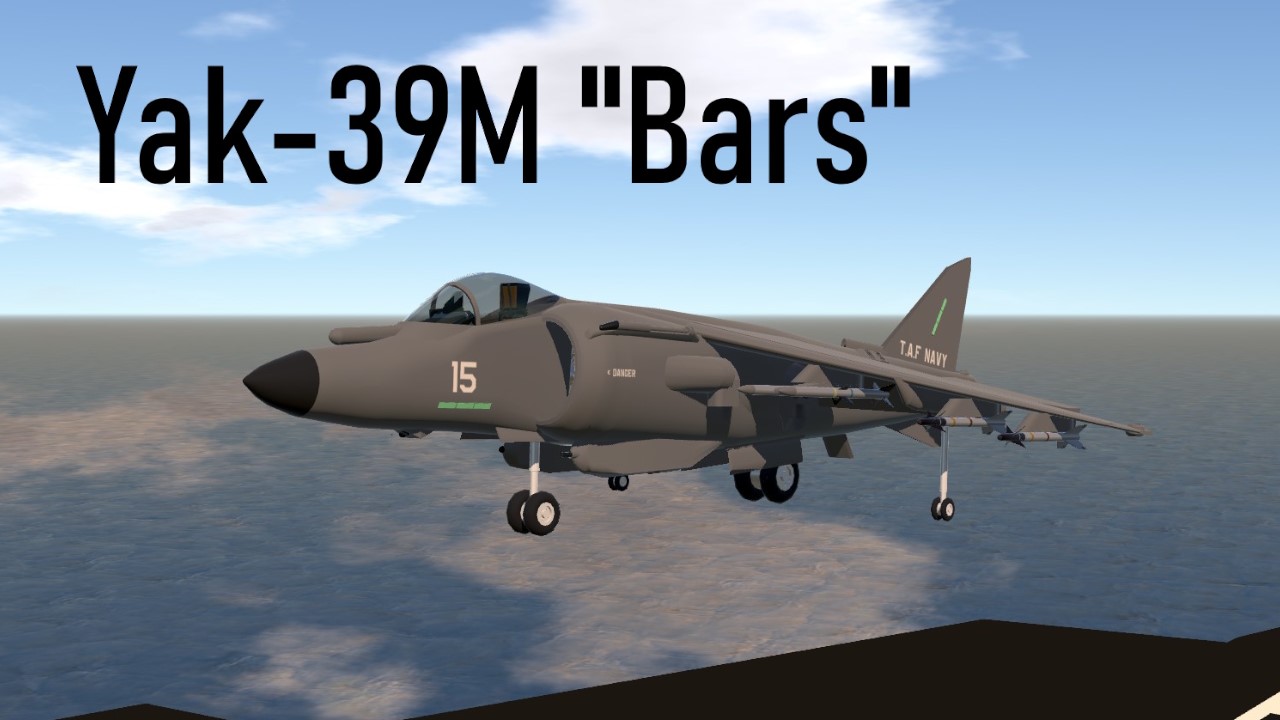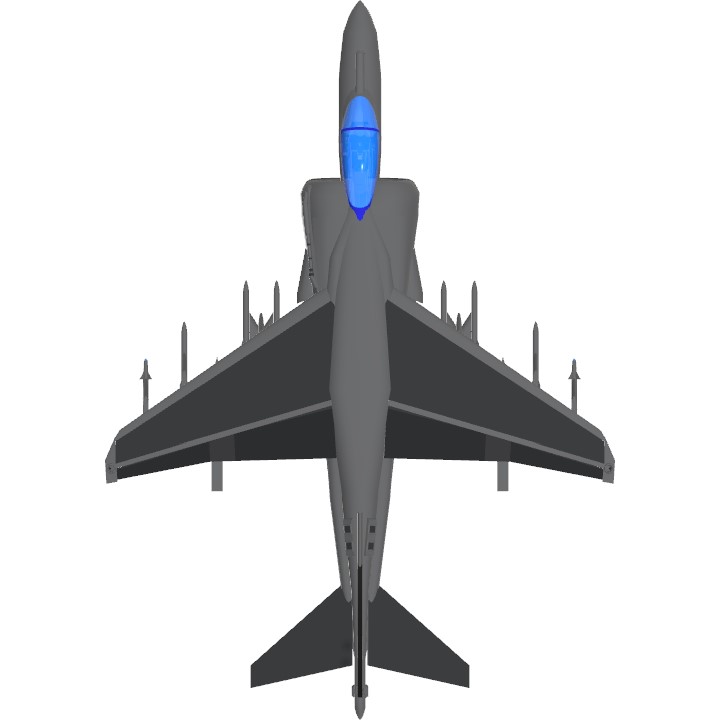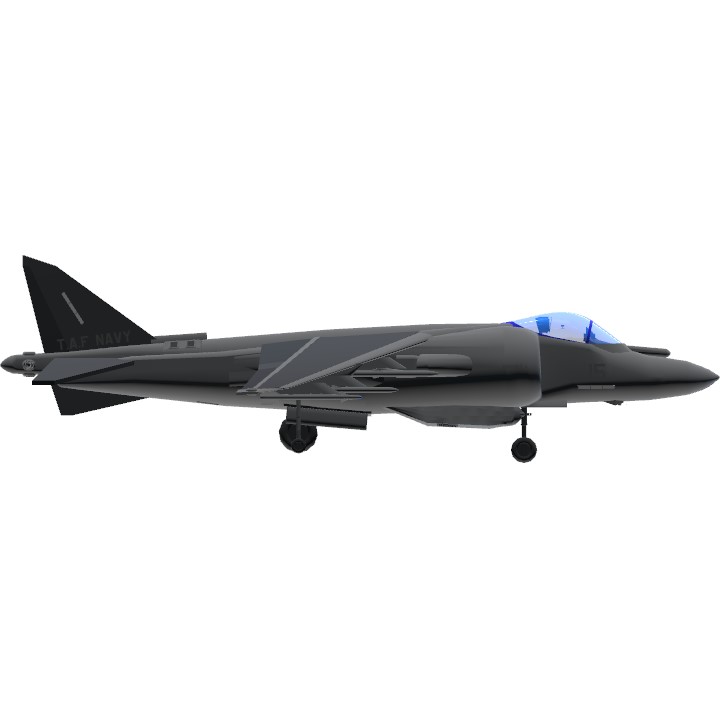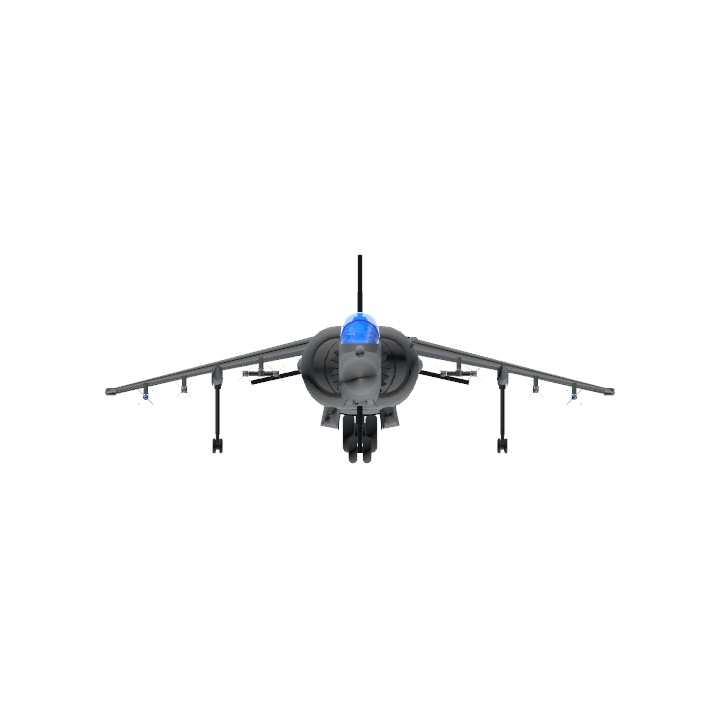Good morning, afternoon, or evening, whenever you are reading this, may the Lord bless you.
Today I introduce you to...
Yak-39M "Bars"
Today I'm sharing this model, which I modified not long ago, but which I plan to upload so I don't leave this page too often. It's a modified and modernized "Vertigo," not much in appearance but rather in technology. As you know, the "Vertigo" is heavily based on an AV-8B Harrier II, to the point of literally being one.
History of the Yak-39M "Bars" (Fictional)
The project, named "Yak-39", emerged during the ongoing collaboration between OKB-147 "Vostok" and the Russian aircraft development company "Yakovlev" during continuous years of planning new prototypes. At this point, constant problems arose with the already innovative Russian naval air force aircraft with new VTOL systems, the "Yak-38", which presented deficiencies to the point of being nicknamed "Widowmaker" due to its high accident rate during takeoffs and landings in vertical flight and its performance problems. Finally, Yakovlev agreed with OKB-147 "Vostok" to begin development of a new aircraft that would solve all the problems that the Yak-38 was already experiencing. The "Izdeliye Y39" prototype was presented, which would be an aircraft that would have the same design as the AV-8B Harrier II but this time with Russian technologies at that time collaborated with OKB-147.
The project was simple, a direct copy of the entire AV-8B Harrier design but with more advanced modifications. A modern cockpit was used that would provide comfort for the pilot, although... MFD (Multi-Functional Display) screen technology was very new at the time and was just being adapted to new fighter jets. The AV-8B Harrier II already had these systems but they were not very advanced. At this point, OKB-147 "Vostok" took an important role in the matter, being the main planner and developer of the cockpit.
La cabina rapidamente tomo forma avanzada siendo bastante basada en la cabina del futuro "Yak-141" pero con mayor disponibilidad de pantallas MFD. Se opto por tener dos pantallas MFD, una a la izquierda que sería para la disponibilidad de armamento en el avión, una al centro que tendría el escaner de radar, y finalmente la 3ra que sería la computadora principal del avión en la cuál se ubicaria el radar con sistemas RWR modernos y marcadores de objetivos Air-Air como Air-Ground. aunque esta tambien tendria la responsabilidad de hacer funcionar el Targeting Pod "T112" que era el pod de targeting mas nuevo de aquel entonces desarrollado por la OKB-147.
But... what happened? The design on which the "Izdeliye Y39" prototype was being based was already an aircraft quite focused on ground attack but it did not have air superiority capability and at that time WVR and BVR combat were of utmost importance in all aircraft, so during the 1st stage of testing of the "Izdeliye Y39" prototype it was called with a specific name Yak-39 "Bars" which would have AirToGround armament using "AGM-38M" missiles and AAM-9X M2 missiles. The cockpit had optimizations with what would be the final cockpit, this had major differences with the one that was finally determined in the Yak-39M and was quite basic although it maintained similarities.
Both companies realized how bad the Yak-39 was, it had the best AGM missiles, and AAM missiles that were of average performance, but did not meet the requirements of combat aircraft of that time... However, this did not discourage the developers, it was thought to leave the cockpit with its final design that had already been determined how it would be, and change the armament that this new naval combat fighter could carry.
Separate Development::
At that time there were many advanced BVR capability missiles developed by OKB-147 "Vostok", but it was thought that it would be better to develop a new line of missiles that were based on the Japanese AAM missiles "AAM-4" and merge them with the "AIM-120" design specifically to arm new aircraft like this prototype "Izdeliye Y39", at first it was crazy to think this and merge missile designs, clearly it did not turn out as thought or expected ... The first missile developed by OKB-147 based on this design was called "AAM-14A", a design based on the AIM-120 and AAM-4 tail fins, it had a range of no more than 80km and a G Overload of 37gs.
It was a new Fox 3 missile that was thought to be successful, but it was a failure in ECM resistance... This was only the first step to give birth to the new AAM-14B, which would meet better expectations in its planning stages, a design almost identical to the Japanese AAM-4, this one with a range of 125km, G Overload of 38gs and quite advanced ECM resistance. It passed the testing stage and met many expectations that the AAM-14A could not, and thus the OKB-147 "Vostok" was proud of the new AAM-14B.
Continuation Of Main Development:
It was eventually incorporated into the "Izdeliye Y39" prototype, along with AAM-9M missiles derived from the AAM-9R, as an export version. It thus became the Yak-39M "Bars." It passed the testing stage and became a source of pride for OKB-147 "Vostok" and the Yakovlev company. The Yak-39M entered mass production, and gained extensive control over the maritime border surveillance carried out by the T.A.F. NAVY.
A rather American exterior design to our eye, but a rather Russian and modern interior design, it became the best BVR naval combat fighter at that time.
Having concluded this, I only wish you a very nice day, afternoon or evening and that the Lord bless you enormously and keep you wherever you go.
AIRCRAFT ARMAMENT CHARACTERISTICS:
- x6 Misiles "AAM-14B".
- x2 Misiles "AAM-9M".
- "T112" Targeting Pod.
- "GSh-30-1" Automatic Cannon. (THE VERTIGO'S MAIN GUN WAS REMOVED AND REPLACED FOR AIR COMBAT)

"T112" Targeting Pod

"GSh-30-1" Automatic Cannon

Yak-39M "Bars" firing an AAM-14B missile
Specifications
General Characteristics
- Predecessor Vertigo
- Created On Windows
- Wingspan 37.2ft (11.3m)
- Length 52.5ft (16.0m)
- Height 15.1ft (4.6m)
- Empty Weight 21,076lbs (9,560kg)
- Loaded Weight 30,577lbs (13,869kg)
Performance
- Power/Weight Ratio 1.146
- Wing Loading 89.8lbs/ft2 (438.4kg/m2)
- Wing Area 340.5ft2 (31.6m2)
- Drag Points 9048
Parts
- Number of Parts 543
- Control Surfaces 5
- Performance Cost 2,507






